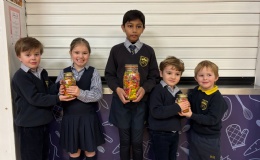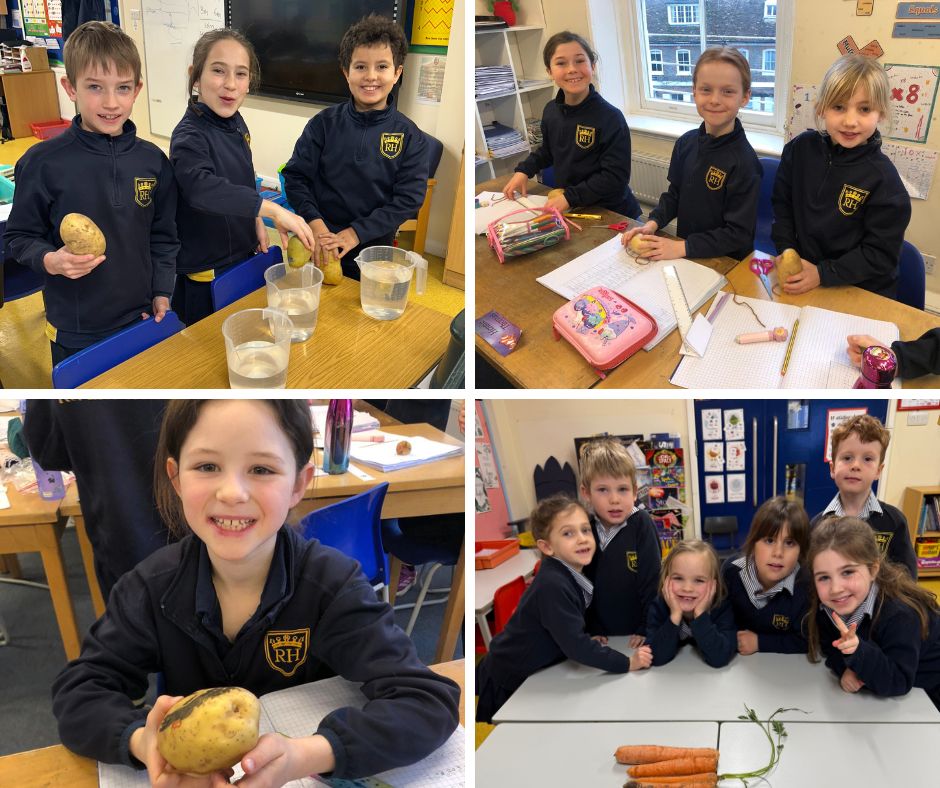
Welcome to Rupert House

On Friday 7th February we celebrated NSPCC National Number Day across the school.
On Friday 7th February, Rupert House School celebrated NSPCC National Number Day in style, with a ‘guess the number of sweets’ competition and a range of Maths-related activities using carrots and potatoes. As a school we raised just over £180 for the NSPCC, Britain’s oldest children’s rights and well-being charity now in its 141st year. Every year group in the school, from Nursery to Year 6, played a big part in both the fundraising and the mathematical fun.
As a build-up to the day itself, the Maths activities started at the beginning of the week, when each year group had a different special number to focus on for their lessons. Across the week, children also had the opportunity to estimate the number of sweets in one of several large jars of jellybeans, with a £1 donation to the NSPCC securing their entry into the competition. On Friday morning, the winners were announced. But the day was only just beginning! Each child brought in a vegetable – carrots in Pre-Prep and potatoes in Prep – to use in their lessons.
Nursery children measured each other in carrots! They found that the average nursery child is 5 carrots long. Mrs Steer and Mrs Stirling were 8 carrots long, but Mr McCook is 10 carrots long! The children placed their carrots in order of length and talked about our special number, 10. Earlier in the week, Nursery children looked at all the different ways of representing and spotting 10, such as 10 fingers, 10 claps, 10 pencils, 10 on a clock. We coloured in some number 10’s. They coloured in a number with Disney’s Top 10 songs playing in the background.
Reception children used tweezers to line up ten pom poms and to count ten dinosaurs, sorting them into coloured categories. In Maths lessons, they focused on number recognition to 10 and composition using coloured blocks and Numicon manipulatives. With the carrots, Reception children used blocks to measure the length and put them into size order, before finally using the carrots for printing a number line with bright orange paint.
Year 1 children had plenty of fun Maths activities with their carrots! They measured the length of each carrot in centimetres, weighed it in grams, arranged the carrots into different shapes, and sorted the carrots from longest to shortest. Using the measurements of the biggest carrot (a whopping 26cm), it would take 1,200 carrots to be as tall as the Eiffel Tower! Earlier in the week, Year 1 children completed various activities focused on the number 20. We discussed all the different ways to make 20 pence, played a ‘number bonds to 20’ game, and found all the whole numbers that add to 20. Additionally, we challenged ourselves to see how many times we could write our names in 20 seconds and how many star jumps we could do in 20 seconds.
Year 2 measured their carrots, using skills like weighing, ordering and measuring length. They loved working in groups and as a whole class to gather their results. They focussed throughout the week on the number 100, practising number bonds and multiplying by ten up to 10 x 10.
Year 3 and 4 got stuck into working with their potatoes, weighing them and finding their circumference. Focussing on the number 1,000, Year 3 children used estimation and column addition to make the number 1000. On Friday, the Year 3 children compared the length and weight of their potatoes and then calculated how many potatoes it would take to run the length and width of the classroom. Year 4 children focused on the number 0.1 as a way to hone skills of working with fractions and decimals.
Year 5 and 6 focussed throughout the week on square numbers and the number π (pi), respectively. The children calculated the volume of their potato by measuring the amount of water that their potato displaced. While Year 5 children learned more about square and cube numbers, square and cube roots and irrational numbers (such as √2), Year 6 children calculated the circumference of circles and the volume of spheres, cylinders and cones using π and substituting values into now-standard formulae first derived by the ancient Greek mathematician Archimedes.
For children in Year 5 and 6, the vegetables became a real feature of other lessons that day, too! In Mrs Clough’s English lessons, the Year 5 and 6 children composed short stories about their potato, with titles including ‘A Day in the Life of Katie Potato’ to a handy guide ‘For Newbie Potato Owners’.
Well done to all the children in the school for getting stuck into a wide range of learning as well as raising money for an important cause.
The winners of the sweets were James in Nursery, Wilfred W in Reception, Ellerie M and Rufus M in Year 1, and Kam P in Year 6.



